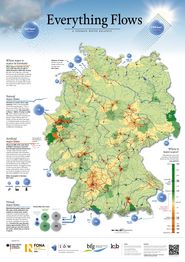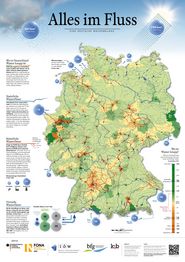World Water Day: New Poster Provides Interesting and Surprising Facts about Water in Germany
There is a lot of water in Germany, but water availability and consumption differ considerably from region to region. To mark World Water Day on 22nd March a new, updated version of the poster ‘Everything Flows – A German Water Balance’ has been published in German and English by the Institute for Ecological Economy Research (IÖW). The poster shows where there are local water shortages and where shortages could worsen due to climate change. It can now be ordered from the German Association for Water, Wastewater and Waste (DWA). The poster is suitable for anyone who wants to broaden their knowledge about water-related issues, from schools to further education institutions to specialists working in the water sector or related fields.
The poster demonstrates how Germany’s natural, artificial and virtual water flows are closely related. It shows, for example, which of the country’s conurbations are not able to obtain enough water locally and have to rely on water being transported via long-distance pipelines, some of which are over 100 km long. In addition, the poster shows which areas lack clean water for agriculture due to intensive fertilisation practices, and how much virtual water Germany imports via agricultural products from around the world. The poster was compiled as part of the research project ‘Water Flows in Germany’, which is led by the IÖW and sponsored by the German Federal Ministry of Education and Research (BMBF) under the funding priority ‘Sustainable Water Management’ (NaWaM). The IÖW’s partners for this project were the German Federal Institute of Hydrology (BfG) and ‘keep it balanced’.
Why would Stuttgart be left high and dry without Lake Constance?
IÖW water expert Jesko Hirschfeld: “You can use this fold-out poster to go on a voyage of discovery around Germany and see how we use water. In many regions we have plenty of water, whereas in other regions we don’t have enough – and climate change could make it worse. When you fold out the poster you can see straight away which regions are most affected.” The poster also answers other questions, such as why Stuttgart would be left high and dry without Lake Constance, how much water we use in Spain for the tomatoes that we import, and why we import grey water with almonds and green virtual water with soya.
The water balance – how much natural, artificial and virtual water flows in Germany – is clearly illustrated. Hirschfeld: “We have depicted volumes of water as spheres so that they’re easy to compare and contrast. The amount of water available here, the amount we consume and the amount we use abroad – you can see it all very clearly.”
The poster can be ordered as a paper version, or downloaded from the website www.bmbf.wasserfluesse.de
To order the paper version of the poster go to: www.dwa.de/shop




